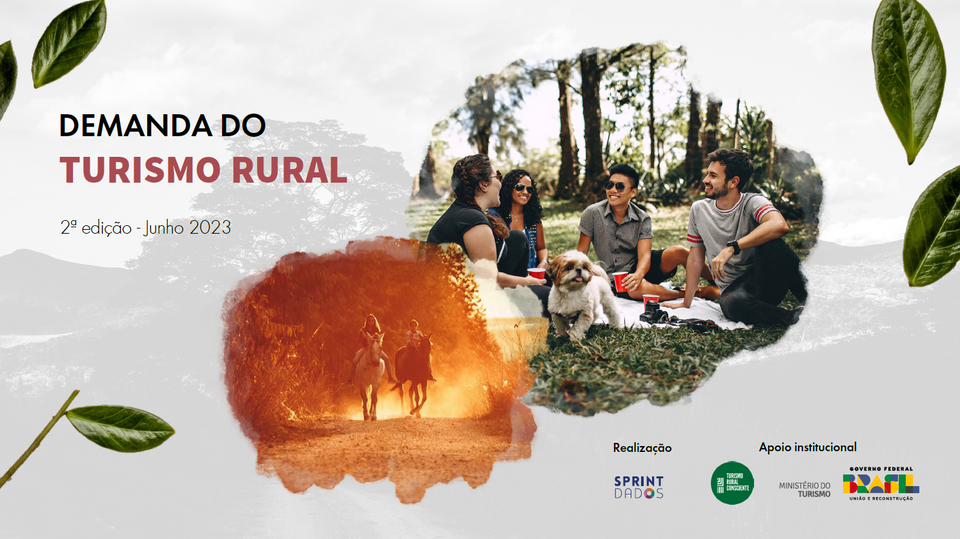We are living in an unprecedented moment for the development of tourism activity in Brazil. During the pandemic, the lack of perspective to make large trips fostered trips close to the space of residence, and more times in the year in addition to vacations and long holidays, which opened space for rural tourism. This practice has taken root in the needs of Brazilians, remaining in the post-pandemic scenario.
About 80% of the Brazilian population lives in cities. Rural tourism is consolidated as an alternative for moments of relaxation, whether to escape the boredom of isolation, or now, at the time of return to the intense pace of the metropolises. This modality provides an outdoor experience, contact with nature and experiences in the interior of the country.
In this sense, SPRINT Dados, a company founded by me, a researcher at LETS, in 2022 carried out the first edition of the Brazilian Rural Tourism Demand Survey, which had the institutional support of the Ministry of Tourism. The objective was to know the profile, preferences and needs of the Brazilian public in relation to Rural Tourism, in order to increasingly improve the tourist products and services of this segment and subsidize planning and investments.
The 1st edition resulted in a Electronic book free of charge, freely distributed in PDF format, which had more than 300 Downloads since its publication. We also presented the results at an event online , which had 88 people watching live, and already has more than 280 views.
In order to update the data, expand the sample and bring even more visibility to the study, we carried out the second edition of the survey, prepared by SPRINT Data. This edition had a partnership with the Ministry of Tourism (MTur) and the Conscious Rural Tourism Network (TRC). The results were known on June 26, through an event online , which had the participation of Rayane Ruas (CEO, Sprint Dados), Anna Modesto (Ministry of Tourism) and Aline Moraes (Conscious Rural Tourism Network).
The survey was carried out over 45 days, from April 20 to May 31, and had the participation of 1,615 people. In the presentation of the results, I was able to show the data in three sections: characterization of the public; tourist preferences; planning and booking a trip.
In Characterization of the audience , in the profile of travelers, 63% of females and 36% of males prevailed, with a predominant age of 39 to 50 years. It should be noted, however, that there was a 6% increase in the age between 51 and 69 years. They are travelers with a high formal education, since 35% have a postgraduate degree. In addition, 48% are married, 28% work as public servants, 32% have an income between 4 and 6 minimum wages and 50% travel with their families. The trips take place on average three times a year and, when going to rural areas, for 26.6% of the public, being with the family is the most important.
The data and information from the characterization of the public are useful for segmentation of the rural tourism enterprise or destination. We noticed that family travel continues to dominate, but the data show that there are many tours made only by the couple and with groups of friends. That's why the focus should not only be on entertaining children, it is important to have options of attractions for adults as well.
Contact with nature prevails in the Tourist preferences . For 74% of respondents, the most sought after activity in rural areas is the contemplation of nature and 73% of participants look for the gastronomic authenticity of homemade food. In addition to the activities on the rise, this panel also showed those less sought after by tourists, such as recreation Fulltime , pointed out by only 4% of the respondents. In the item differentiated activity, surprisingly, 50% of the participants answered that they want to learn something new, 47% are looking for activities related to sustainability and 40% are interested in stargazing.
"These data are important and show us that we are on the right track. People think that the fact that they do not have internet on their properties will not work rural tourism. But, the survey shows that tourists are looking for other connections, when we see that 74% are looking to contemplate nature. I often tell my students that this 'nadism' is attractive, it is sitting and doing nothing; just sit and contemplate nature and remember that we are part of it", highlighted Aline Moraes, coordinator of the Conscious Rural Tourism Network.
The survey also pointed out that for 68% of respondents, contact with nature is the main reason for traveling to rural areas. This trip takes an average of three days and the distance traveled to reach the rural destination is between 250 and 500 kilometers.
"Rural tourism requires simplicity. We don't want mass tourism. Tourists are looking for delicious food, wood stoves, inputs harvested from the garden. The minister said last week that rural tourism is a new trend that is here to stay," said Anna Modesto, from the General Coordination of Tourism Products and Experiences of the Ministry of Tourism (MTur).
In Planning and booking of a trip, the survey showed that 51% plan to travel to rural areas on weekends. It is worth remembering that throughout the year there are 52 weekends that can be business opportunities for rural enterprises. Regarding the most used means to make reservations, 52% follow the recommendations of friends and family, use social networks and Sites . Tourists are willing to pay daily rates that cost between R$ 250 and R$ 500.
Minas Gerais, São Paulo and Rio Grande do Sul are the states with the highest demands for Brazilian rural tourism. To know the complete list of states, just consult the interactive panel on link Rural Tourism Demand | SPRINT DATA
The survey data show that rural tourism has great potential. They indicated that the traveler is interested in nature and the rural environment, prioritizes comfort and simplicity in search of escaping the hustle and bustle of the city. It is an audience made up of families who visit the rural environment on average three times a year, with an average stay of three days, use social networks and recommendations from friends as the main means of information and make reservations directly at the development.
All this data will allow the market to make the best decisions. Take ownership of this information.
The full result of the study is available to the public free of charge in Electronic book , and an interactive data dashboard. Both can be accessed at www.sprintdados.com.br/turismorural .


